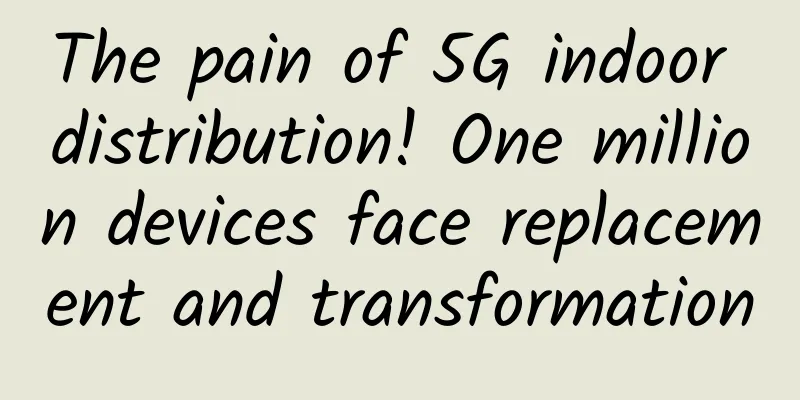The pain of 5G indoor distribution! One million devices face replacement and transformation

|
Indoor coverage is the new battlefield for 5G. More than 70% of 5G applications such as smart homes, smart factories, AR/VR, etc. occur indoors, but 5G higher-frequency band signals cannot reach indoors from outdoors. Therefore, deepening indoor coverage and enabling application innovation are the keys to 5G commercialization. Indoor coverage is a new pain point for 5G. Higher frequency bands, more antennas, and richer applications are all "impossible missions" that traditional indoor distributed systems cannot accomplish. There are three reasons: 1) Frequency band Traditional indoor passive components have large losses in the 5G mid-frequency band and are difficult to meet the index requirements; as for the 5G millimeter wave high-frequency band, it is a completely different set of equipment. If deployed in the traditional indoor manner, the complexity is too high. 2) MIMO 5G requires more antennas, 4T4R or more. For the traditional indoor distribution method of one antenna corresponding to one channel, the engineering is complex and expansion is difficult. As you know, if there is no higher-order MIMO, beamforming and other technologies, it is not called 5G, and it cannot be called 5G indoor distribution. 3) Application Indoor distributed systems should introduce edge computing to open up service capabilities and give rise to richer 5G indoor applications. If you don’t talk about edge computing these days, you’d be embarrassed, but traditional indoor distributed systems cannot achieve this. In short, traditional indoor distribution systems have failed to keep up with the pace of technological evolution. It is estimated that more than 500,000 traditional indoor distribution systems in China and about 1-2 million traditional indoor distribution systems worldwide will face gradual upgrades and replacements.
At this moment, let us review the development history of indoor partition. Passive indoor distribution system The earliest indoor distribution system is called a passive distribution system. The RF signal is directly split through passive devices such as couplers, power dividers, and combiners, and the signal is transmitted to antennas distributed indoors by feeders. This method has been used for many years, but it has four major disadvantages: ①The feeder line loss is large and the quality of passive components is uneven. ② Because the feeder line diameter is thick, and with the upgrade of 2G/3G/4G and the application of MIMO multi-channel, the upgrade construction is becoming more and more difficult. ③ It is usually necessary to amplify the source signal, which will increase the system noise floor, shrink the uplink coverage, and affect the network KPI indicators. ④ It is difficult to achieve complete real-time monitoring of the network, and management and maintenance troubleshooting are difficult. Active indoor distribution system Subsequently, indoor distribution systems entered the era of active distribution systems, which are usually divided into traditional fiber optic distribution systems and multi-service fiber optic distribution systems. The traditional fiber optic distribution system consists of a near-end unit, a remote unit and an antenna feeder. The RF signal directly coupled by the base station is converted into an optical signal, which is transmitted to the remote unit distributed indoors by optical fiber, and then converted into an electrical signal, which is amplified by an amplifier and transmitted to the antenna. The multi-service fiber optic distribution system consists of three parts: access unit, near-end extension unit, and remote unit. The access unit couples the RF signal from the base station and converts it into a digital RF signal, which is transmitted to the extension unit through optical fiber; the extension unit splits the digital RF signal from the access unit and transmits it to multiple remote units through Category 5 cables or network cables; the remote unit achieves the coverage of the system RF signal and adopts DC power supply or POE power supply through optical fiber composite cable. Compared with passive systems, active indoor distribution has several advantages: ①More antennas can be connected to provide a wider coverage area. ②It can effectively support MIMO technology and improve the speed. ③Multi-device node networking makes expansion and upgrading easy. ④ Basically no passive devices are used, which reduces the difficulty of property coordination and construction. ⑤ Comprehensive monitoring from signal source access to the terminal can be realized. However, the multi-service fiber optic distribution system needs to connect to the RRU as the signal source, and the nature of its repeater power relay remains unchanged, and the problem of raising the system noise floor cannot be avoided. As a result, the indoor distributed system began to evolve towards a flatter, simpler and more flexible architecture, which is the new digital indoor distributed system represented by Huawei Lampsite and Ericsson Radio Dot. New digital room distribution system The main advantages of the new digital room distribution system are: ①Supports 5G frequency band, solving the physical limitations of traditional passive indoor distribution and the system complexity of active indoor distribution. ② The RF remote control directly connected to the BBU can be independently demodulated to improve the noise factor. ③Support MIMO multi-channel evolution. ④Visual operation and maintenance management can be realized. ⑤Support the development of 5G multiple services. Looking at the history of indoor distribution, 5G indoor coverage is both a pain point and an opportunity. Huawei and Ericsson have already released a new generation of 5G-specific Lampsite and Radio Dot products before 5G commercialization, laying out the indoor market in advance. At the same time, some traditional indoor distribution manufacturers are also actively transforming. For example, CommScope acquired Small Cell supplier Airvana and launched products that combine indoor distribution systems with cloud-based C-RAN; Corning acquired SpiderCloud to develop scalable Small Cells systems. Facing the vast indoor market in the future, an indoor battle is already brewing. The new digital indoor distribution has entered the stage of the times. How long will it take for the traditional indoor distribution to end? Faced with reality, even if the new digital indoor distribution is oriented to the 5G future, it is estimated that it will take several years to upgrade or replace the traditional indoor distribution of millions of sets. Will this process leave time and space for unlicensed spectrum technologies such as WiFi, severely slapping the face of those who say that 5G will kill WiFi? |
<<: Will 5G replace NB-IoT immediately after commercialization? Not really!
>>: China only holds 10% of 5G patents? Don’t worry, there is still a long way to go.
Recommend
spinservers: 10Gbps bandwidth US server $99/month - 2*E5-2630Lv3/128GB/1TB NVMe/30TB/month
spinservers has just released this month's pr...
ZJI: Hong Kong VDS Superset Series 20% off 450 yuan/month, Platinum 8352Y/16G memory/240G SSD/10M CN2+BGP
ZJI is the original well-known WordPress host Wei...
Ericsson and Samsung settle patent dispute
According to foreign media, Ericsson has reached ...
DediPath Summer Promotion: Los Angeles E3 servers start at $39 per month, New York servers start at $49 per month
DediPath has released its latest summer promotion...
IPv4 addresses are exhausted. Let’s discuss IPv6 penetration and IP migration complexity.
[[283967]] As a basic resource, IPv4 has supporte...
Analysis of the reasons for IP address blocking and the help of IP proxy for IP restriction
In addition to the support of basic network cable...
Qualcomm: The invention of these key technologies has driven the expansion of 5G!
Today, we are in the process of rapidly expanding...
Multi-access Edge Computing – Part 2: Security Challenges of Securing MEC
Continued from: Multi-access Edge Computing – Par...
Inventory: Ten key steps in the development of quantum communication in China, from following to partially leading
[[408654]] 01 Deceived-state quantum key distribu...
Microsoft: Azure Quantum quantum cloud platform is now open for public preview
Microsoft's Azure Quantum cloud platform uses...
White label revolution, fighting together to carve out a bloody path
In recent years, the hottest topic in the network...
New infrastructure defines the new connotation of data center
At this year's National People's Congress...
Analysis: Advantages and limitations of wireless data centers
For data center operators, the idea of a wirele...
5G technology revolutionizes many industries!
The transformative power of 5G is at the forefron...
5G is so good, but how many people can afford the data charges?
In the past 2019, with the issuance of 5G commerc...
![[Black Friday] DediPath: Dedicated servers in multiple data centers in San Jose/Los Angeles/New York/Dallas starting from $39/month](/upload/images/67cac01eb166c.webp)








